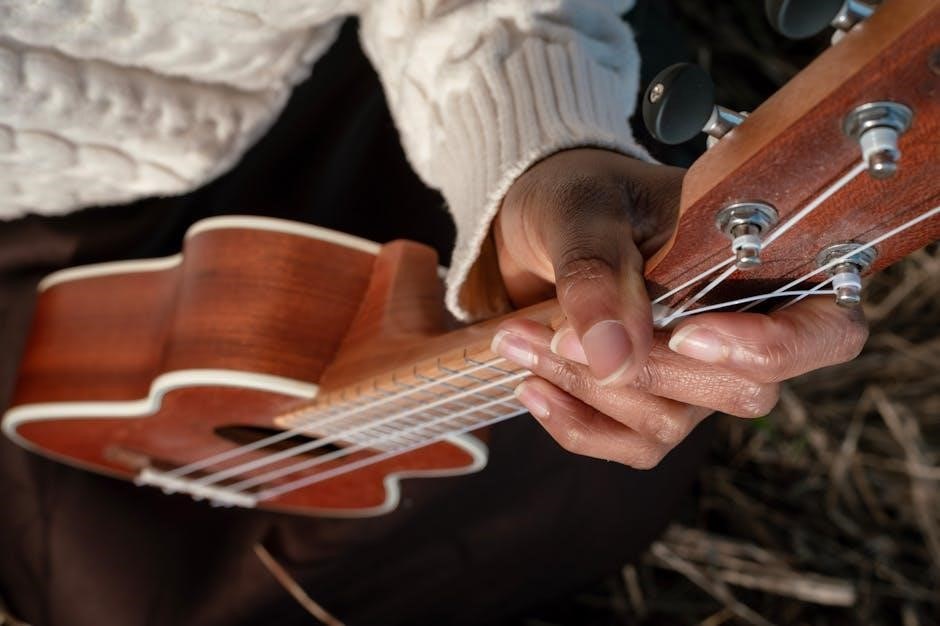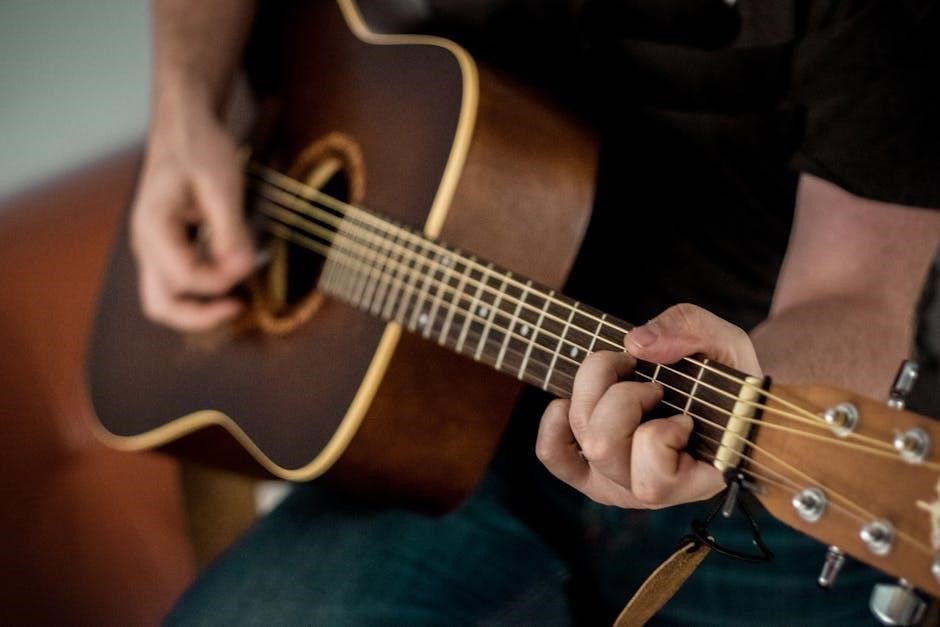Chord progressions are fundamental to guitar playing, forming the harmonic foundation of songs. They create emotional depth and structure, guiding listeners through musical journeys. Understanding chord progressions enhances composition and improvisation skills, allowing guitarists to express emotions effectively. With resources like chord progression PDFs and diagrams, musicians can explore various styles and techniques, from simple sequences to complex harmonic arrangements, making them indispensable for both beginners and seasoned players.
What Are Chord Progressions?
A chord progression is a series of chords played in a specific order, forming the harmonic structure of a song. It establishes tonality, guiding the music’s emotional journey. Chords are built from scales, and their sequences create movements that resonate with listeners. Roman numerals are often used to represent chords, making progressions adaptable to any key. From simple sequences like I-IV-V to complex jazz harmonies, chord progressions are the backbone of music composition, enabling guitarists to craft memorable melodies and evoke powerful emotions across various genres.
The Importance of Chord Progressions in Music
Chord progressions are the backbone of music, providing harmonic structure and emotional depth. They establish tonality, guiding the listener through a song’s narrative. By creating movement and resolution, progressions evoke feelings and maintain engagement. Their versatility allows adaptation across genres, from rock to jazz, making them a universal tool for composers. Whether simple or complex, chord progressions are essential for crafting memorable melodies and harmonies, forming the foundation of modern music composition and performance.
Why Guitarists Should Learn Chord Progressions
Learning chord progressions empowers guitarists to compose, improvise, and adapt songs across genres. They unlock the ability to create emotional depth and structure in music. Progressions provide a framework for understanding harmony, enhancing both original songwriting and cover performances. With resources like chord progression PDFs, guitarists can explore various styles, from rock to jazz, and develop a richer musical vocabulary. Mastery of chord progressions expands creative possibilities, making them indispensable for any guitarist aiming to grow musically and connect with audiences more profoundly.

Understanding Guitar Chords and Scales
Mastering guitar chords and scales is essential for creating harmonious progressions. Chords are built from scales, providing the foundation for melody and harmony in music. This connection enables guitarists to craft meaningful sequences and transitions, enhancing their playing and composition skills.
Basic Guitar Chords for Beginners
Mastering basic guitar chords is the first step in understanding chord progressions. Essential open chords like C, G, Am, Em, D, and E are foundational for beginners. These chords are used in countless songs and provide a solid starting point for building progressions. PDF guides often include chord diagrams, making it easier for new players to learn proper finger placement and shapes. Practicing these chords and their transitions helps develop muscle memory and smooth playing. Starting with simple progressions using these chords builds confidence and lays the groundwork for more complex harmonies.
Major and Minor Scales in Guitar Playing
Major and minor scales are the foundation of music theory and guitar playing. A major scale follows a specific whole and half-step pattern, creating a bright, uplifting sound, while a minor scale has a different pattern, producing a sad or introspective tone. These scales are essential for building chords and melodies. Guitarists use scales to create solos, melodies, and chord progressions. Understanding major and minor scales helps in composing and improvising. PDF guides often include scale diagrams, making it easier to learn and visualize their shapes on the fretboard. Practicing scales enhances technical skill and harmonic awareness, crucial for mastering chord progressions.
How Scales Relate to Chord Progressions
Scales form the foundation of chord progressions, as chords are built from specific degrees of a scale. Each scale degree corresponds to a chord, often labeled using Roman numerals. For example, in a major scale, the I, IV, and V chords are major, while the ii, iii, and vi chords are minor. This relationship allows guitarists to create cohesive progressions by targeting specific notes and chords within a scale. Understanding how scales relate to chords enables musicians to craft meaningful melodies and harmonies, ensuring smooth transitions and emotional resonance in their music.

The Roman Numeral System in Music
The Roman numeral system represents chords relative to a key, using uppercase for major and lowercase for minor chords. It simplifies understanding chord functions and relationships, enabling universal application across keys and instruments, while maintaining harmonic structure and emotional depth in compositions.
The Roman numeral system simplifies chord identification by assigning numbers to scale degrees. Uppercase numerals denote major chords, while lowercase indicate minor chords. This system is universal, allowing guitarists to transpose progressions effortlessly across keys. By understanding Roman numerals, players can recognize chord functions and relationships, enhancing their ability to compose and improvise. This method is particularly useful for exploring chord progressions in various musical genres, from rock to jazz, providing a structured approach to harmonic exploration and creativity.
Uppercase vs. Lowercase Numerals: Major vs. Minor Chords
In the Roman numeral system, uppercase numerals (I, IV, V) represent major chords, while lowercase numerals (i, iv, v) indicate minor chords. This distinction helps guitarists identify chord quality within a key. Major chords, like I and IV, provide stability, while minor chords, such as i and vi, create tension. Understanding this system is crucial for constructing and analyzing chord progressions, as it reveals the harmonic structure and emotional impact of a sequence. This foundational knowledge enables guitarists to apply chord progressions effectively across various musical genres and styles.
Diminished and Altered Chords in Roman Numerals
Diminished chords are represented by a superscript circle (°) in Roman numerals, such as vii°, indicating a diminished triad. Altered chords, like flat or sharp variations, are shown with additional symbols (e.g., vii♭5 or vii♯5). These extensions add complexity to chord progressions, enabling richer harmonic textures. In jazz and fusion, altered chords are frequently used to create tension and emotional depth. Understanding these symbols is essential for accurately transposing and composing chord progressions, as they provide precise harmonic information within any key or scale.

Popular Chord Progressions for Guitar
Popular chord progressions like the I-IV-V, I-V-vi-IV, and 12-bar blues are widely used in various genres. These versatile sequences provide a foundation for songwriting and improvisation, offering emotional depth and structural variety that resonate across different musical styles.
The I-IV-V Progression: A Rock Music Staple
The I-IV-V progression is a cornerstone of rock music, offering simplicity and versatility. It follows a harmonic structure that creates a sense of resolution, making it emotionally impactful. This progression is widely used in hit songs like La Bamba and Wild Thing, showcasing its universal appeal. Guitarists can easily transpose it to any key, such as C Major (C-F-G), and adapt it to various styles. Its popularity stems from its ability to evoke strong emotions while providing a solid framework for improvisation and songwriting.
The I-V-vi-IV Progression: A Pop Music Favorite
The I-V-vi-IV progression is a timeless favorite in pop music, known for its emotional depth and versatility. It creates a harmonic journey that resonates with listeners, making it a staple in countless hits like With or Without You and She Will Be Loved. Guitarists can easily adapt this progression to any key, such as C Major (C-G-Am-F), and experiment with variations like adding 7th chords or inversions for a richer sound. Its universal appeal lies in its ability to evoke strong emotions while remaining simple enough for improvisation and songwriting.
Blues Progressions: The 12-Bar Blues
The 12-bar blues is a cornerstone of blues music, characterized by its repeating 12-measure structure. It typically follows the I-IV-V chord progression, creating a soulful, emotional foundation. For example, in E major, the progression would be E-A-B7, often repeated with variations. This structure allows for rich improvisation and storytelling, making it a staple in blues classics like Sweet Home Chicago and Pride and Joy. Guitarists use this progression to convey deep emotion, with its familiar rhythm and harmonic simplicity providing a timeless framework for expression and musical exploration.
Jazz Progressions: ii-V-I and Beyond
The ii-V-I progression is a cornerstone of jazz harmony, creating a rich harmonic movement. It typically features a minor chord (ii), followed by a dominant chord (V), resolving to the tonic (I). Guitarists often use extended chords like 7ths and 9ths for added color. Beyond ii-V-I, jazz explores complex substitutions, such as replacing V with altered or modal interchange chords. Resources like Ted Greene’s Modern Chord Progressions provide deep insights into these advanced techniques, offering guitarists a pathway to master intricate harmonic landscapes and elevate their improvisational skills through structured musical exploration.

Famous Songs Using Common Chord Progressions
Hit songs like Twist and Shout, La Bamba, and With or Without You rely on popular progressions such as I-V-vi-IV, showcasing how timeless chord sequences drive memorable melodies and emotional impact.
Examples of Songs Using the I-IV-V Progression
The I-IV-V progression is a cornerstone of popular music, appearing in countless iconic tracks. Songs like Stand by Me by Ben E. King and No Woman No Cry by Bob Marley utilize this structure to create timeless, memorable melodies. In Stand by Me, the progression is played in A major, while No Woman No Cry uses it in G major. This versatility highlights how the I-IV-V progression can adapt to various genres and emotional contexts, making it a go-to for songwriters. Guitarists can explore these examples to master the progression and apply it to their own compositions.
Hit Songs Featuring the I-V-vi-IV Progression
The I-V-vi-IV progression is a popular staple in pop music, featured in numerous hit songs. Tracks like With or Without You by U2 and She Will Be Loved by Maroon 5 showcase this progression. It creates a memorable, emotionally resonant sound. Guitarists can study these examples to master the progression and apply it to their own music. This sequence is versatile, fitting various genres and moods, making it a favorite among songwriters. Learning these songs helps musicians understand how to craft compelling harmonic structures in their compositions.
Blues Classics and Their Progressions
Blues music relies heavily on the 12-bar blues progression, a cornerstone of the genre. Classics like Twist and Shout and La Bamba use this iconic structure, which typically follows a I-IV-V pattern. Songs such as Earth Angel and Set Fire to the Rain also incorporate blues elements, showcasing the versatility of these progressions. The 12-bar format creates a soulful, rhythmic foundation, allowing for rich improvisation and emotional expression. These timeless tracks demonstrate how blues progressions continue to inspire guitarists and songwriters across generations, making them a vital part of musical history and education.
Jazz Standards: Iconic Progressions
Jazz standards often utilize sophisticated chord progressions, such as the ii-V-I sequence, which is a hallmark of the genre. These progressions, frequently employing extended chords like 7ths and altered tones, create rich harmonic textures. Many jazz classics, including works by legendary artists, rely on these iconic patterns. Resources like Ted Greene’s Modern Chord Progressions and various PDF guides provide detailed explorations of these progressions, offering insights into their construction and application. These materials are invaluable for guitarists aiming to master jazz harmony and improvisation, ensuring the legacy of these timeless standards endures.

Advanced Chord Progression Techniques
Explore modal interchange, chord substitutions, and extended chords to create sophisticated progressions. These techniques, detailed in PDF guides, enhance harmonic depth and uniqueness in guitar playing.
Modal Interchange: Borrowing Chords from Parallel Keys
Modal interchange involves borrowing chords from parallel keys to add color and tension. For example, in a major key, using chords from its minor counterpart creates intriguing harmonic shifts. This technique, often explored in jazz and fusion, enhances emotional expression. PDF guides provide detailed examples, showing how to seamlessly integrate these borrowed chords into progressions. Guitarists can expand their musical vocabulary by experimenting with these techniques, leading to more complex and engaging compositions. This approach is widely used in various genres to create unique and captivating sounds.
Chord Substitutions for Unique Sounds
Chord substitutions are a dynamic way to infuse unique flavors into your guitar playing. By replacing a chord with another that shares a tonal function, you can create intriguing harmonic shifts. For instance, swapping a major chord with its relative minor adds emotional depth. Extended chords like 7ths or 9ths enrich the sound, while modal interchange allows borrowing from parallel keys to introduce tension and resolution. Diminished or altered chords can add drama, offering surprising harmonic twists. These techniques, explored in depth in various PDF guides, empower guitarists to craft distinctive and captivating musical landscapes, enhancing both creativity and emotional expression in their compositions.
Using Inversions for Smooth Transitions
Chord inversions are a powerful technique for creating smooth transitions in guitar progressions. By rearranging the notes of a chord, inversions allow for seamless voice leading between chords, minimizing abrupt changes in pitch. This enhances the musicality of a progression, making it sound more polished and professional. Inversions are particularly useful in jazz and fusion styles, where complex harmonies are common. Guitarists can use inversions to maintain a consistent bass line or to add variety to repetitive chord sequences. PDF guides often highlight practical applications of inversions, offering exercises and examples to master this essential technique for harmonic depth and fluidity in compositions.
Extended Chords: 7th, 9th, and Altered Chords
Extended chords, such as 7th, 9th, and altered chords, add complexity and depth to guitar progressions. These chords introduce additional tones, creating richer harmonies and emotional nuance. A 7th chord adds a seventh interval, while 9th chords include an octave plus a ninth. Altered chords modify the basic chord structure with sharps or flats, offering unique sounds. PDF resources provide detailed diagrams and examples, making it easier for guitarists to incorporate these advanced chords into their music. They are essential for jazz and fusion styles, enabling players to craft sophisticated and memorable progressions that stand out.

Genre-Specific Chord Progressions
Explore chord progressions tailored to specific genres, such as rock, jazz, blues, and country. Each genre offers unique harmonic patterns, providing guitarists with versatile emotional expression and stylistic authenticity through PDF guides.
Rock and Pop Progressions
Rock and pop music rely heavily on iconic chord progressions like the I-IV-V and I-V-vi-IV, which have become staples in countless hit songs. These progressions are simple yet powerful, creating catchy and memorable melodies. Guitarists often use open chords and capo positions to enhance playability. The I-IV-V progression, for example, is a cornerstone of rock music, while the I-V-vi-IV sequence dominates pop charts. Both styles adapt well to variations, such as adding 7th chords for depth or experimenting with chord substitutions. These progressions are versatile, fitting various subgenres and moods, making them essential for any guitarist aiming to craft modern, radio-friendly sounds.
Jazz and Fusion Progressions
Jazz and fusion progressions are known for their complexity and harmonic richness, often utilizing extended chords like 7ths, 9ths, and altered chords. The ii-V-I progression is a jazz staple, while more intricate sequences like iii-vi-ii-V and modal interchange (borrowing chords from parallel keys) add sophistication. Fusion blends jazz with rock and world music, incorporating syncopated rhythms and exotic scales. Guitarists often use chord substitutions and inversions to create smooth transitions. Resources like Ted Greene’s “Modern Chord Progressions” provide invaluable insights into these advanced techniques, helping musicians craft intricate, emotionally resonant pieces for improvisation and composition.
Blues and Country Progressions
Blues progressions are rooted in the 12-bar structure, often using I, IV, and V chords, with variations like the quick change. Country progressions frequently employ I, IV, and V chords but with a twangy, storytelling feel. Blues relies on 7th chords for its distinctive sound, while country may incorporate suspended or major 7th chords for added texture. Both genres emphasize rhythmic feel, with blues often using a shuffle or swing rhythm and country favoring a straightforward, driving strumming pattern. These progressions are foundational for creating authentic, emotive music in these styles, with resources like chord charts and PDF guides aiding exploration and mastery.
Folk and Classical Progressions
Folk and classical progressions often rely on simple, timeless chord sequences that evoke emotional depth. Folk music frequently uses I, IV, and V chords, creating a storytelling atmosphere. Classical progressions, inspired by traditional compositions, may incorporate minor chords and arpeggios for sophistication. Common sequences include I-V-vi-IV or I-IV-V, with variations to suit the mood. These progressions are well-suited for fingerpicking techniques, adding texture and complexity. Resources like chord charts and PDF guides provide detailed breakdowns, helping guitarists master these elegant and expressive styles, whether for traditional folk songs or classical-inspired arrangements.

Resources for Learning Chord Progressions
Discover essential resources like chord progression PDFs, online tools, and books. Explore Roman numeral charts, chord diagrams, and tutorials. Websites like ChordsLOL offer interactive charts and downloads for guitarists.
Recommended PDF Guides for Guitarists
Explore comprehensive PDF guides tailored for guitarists, offering detailed chord progressions, diagrams, and scale relationships. Resources like the “Illustrated Chord Progressions” ebook provide diverse progressions with clear diagrams, aiding learning. Ted Greene’s “Modern Chord Progressions” covers advanced techniques, while “Guitar Chord Progressions” by Guitar-Chord.org offers systematic breakdowns of major scales. These guides cater to all skill levels, from beginners to pros, ensuring a rich learning experience. They often include Roman numeral charts for transposing and practical examples, making them indispensable for mastering chord progressions and expanding musical versatility.
Online Tools for Exploring Chord Progressions
Utilize online tools to master chord progressions, such as interactive charts and progression generators. Websites like https://www.chords.lol/chord-progression-chart offer downloadable PDFs and Roman numeral charts for transposing. These tools provide essential patterns, including I-V-vi-IV and blues progressions, in all keys. They also feature strumming tips and chord substitutions for unique sounds. Online resources are ideal for songwriters and learners, enabling experimentation with inversions and extended chords. They simplify the process of creating harmonically rich music, making chord progressions accessible and engaging for guitarists of all levels.
Books on Guitar Harmony and Progressions
Books like Ted Greene’s “Modern Chord Progressions” and Tom Kolb’s “Modes for Guitar” offer in-depth insights into guitar harmony and progressions. These resources, available as PDFs, provide practical lessons and detailed breakdowns of scales, modes, and chord voicings. They cater to intermediate and advanced players, helping them explore jazz, classical, and other styles. Such books are invaluable for understanding harmonic theory and applying it to real-world playing, making them essential for guitarists aiming to expand their musical knowledge and technique.
YouTube Channels and Tutorials
YouTube offers a wealth of tutorials and channels dedicated to chord progressions for guitar. Channels like GuitarLessons365, Marty Music, and Andy Guitar provide in-depth lessons on chord progressions, covering genres like rock, jazz, and blues. These tutorials often include PDF downloads or printable charts to complement video instruction. They cater to all skill levels, offering step-by-step guides and practical examples. Many channels also explore advanced techniques like modal interchange and chord substitutions, making them invaluable for guitarists seeking to enhance their harmonic knowledge and playing skills. These resources are perfect for visual learners and those who prefer interactive instruction.

Creating Your Own Chord Progressions
Experiment with chord substitutions and variations to craft unique progressions. Use scales, chord charts, and Roman numerals to create versatile sequences. Start simple, explore, and evolve your sound naturally.
Starting with a Simple Idea
Begin by selecting a key and experimenting with basic chord sequences. Use common progressions like I-IV-V or I-V-vi-IV as a foundation. Start with simple, familiar chords and gradually explore variations. Reference chord charts or PDF guides for inspiration; Practice playing progressions slowly, focusing on smooth transitions. Experiment with chord substitutions to add uniqueness. Consider the mood you want to convey and let it guide your choices. Simple ideas often evolve into compelling compositions, so embrace experimentation and creativity from the start. This approach helps build confidence and lays the groundwork for more complex progressions.
Experimenting with Chord Substitutions
Chord substitutions add variety and depth to progressions, allowing for creative expression. Use Roman numerals to identify chords that can replace originals, such as swapping I for iii or IV for ii. Try adding 7th or diminished chords for unique textures. For example, substituting V with V7sus4 creates tension and interest. Explore modal interchange by borrowing chords from parallel keys, like using bVII in a major key. Start with small changes and gradually experiment with more complex substitutions. This technique keeps your music fresh and engaging while maintaining harmonic coherence. Chord substitution charts in PDF guides can inspire new ideas and expand your harmonic palette.
Building Progressions Around a Scale
Building chord progressions around a scale creates cohesive and emotionally resonant music. Start by identifying the scale’s chord tones and constructing triads or seventh chords from each degree. For example, in a C major scale, chords like Cmaj, Dm, Em, and Fmaj can form the basis of progressions. Experiment with arranging these chords to evoke specific moods, such as using minor chords for melancholy or major chords for joy. This method ensures your progressions align with the scale’s harmonic structure, enhancing musicality and versatility. Chord charts in PDF guides can simplify this process by visually mapping chords and their relationships.
Writing Progressions for Different Moods

Chord progressions can evoke distinct emotions by carefully selecting chords and keys. Minor chords often create somber or melancholic moods, while major chords convey happiness or resolution. Experiment with modal interchange or altered chords to add tension and depth. For example, a progression in a minor key with diminished chords can evoke sadness, while a major key with extended chords can inspire joy. Tempo and rhythm also play a role in shaping the mood. Use resources like chord progression PDFs to explore these techniques and craft progressions that resonate emotionally with your audience.
Chord progressions are the backbone of music, offering endless creativity and emotional expression. With practice and exploration, guitarists can master these sequences, unlocking the full potential of their craft.
The Power of Chord Progressions in Guitar Playing
Chord progressions are the heart of music, creating emotional depth and harmonic structure. For guitarists, mastering these sequences unlocks endless creativity and expression. Whether crafting original songs or covering classics, chord progressions provide the framework for storytelling through sound. They allow players to evoke feelings, connect with audiences, and explore genres from rock to jazz. With resources like chord progression PDFs and diagrams, guitarists can learn and master these essential patterns, enhancing their musical understanding and artistry. Chord progressions truly empower guitarists to bring their musical visions to life.
Final Tips for Mastering Chord Progressions
Mastering chord progressions requires consistent practice and exploration. Start by practicing scales, as they form the basis of most progressions. Experiment with substitutions and inversions to add variety and smoothness to your playing. Use Roman numerals to understand chord relationships across keys, enabling easy transposition. Listen to songs and identify progressions to develop your ear. Incorporate extended chords like 7ths and 9ths for richer sounds. Stay curious, explore genres, and keep learning—chord progressions are a lifelong journey of musical discovery and creativity.
